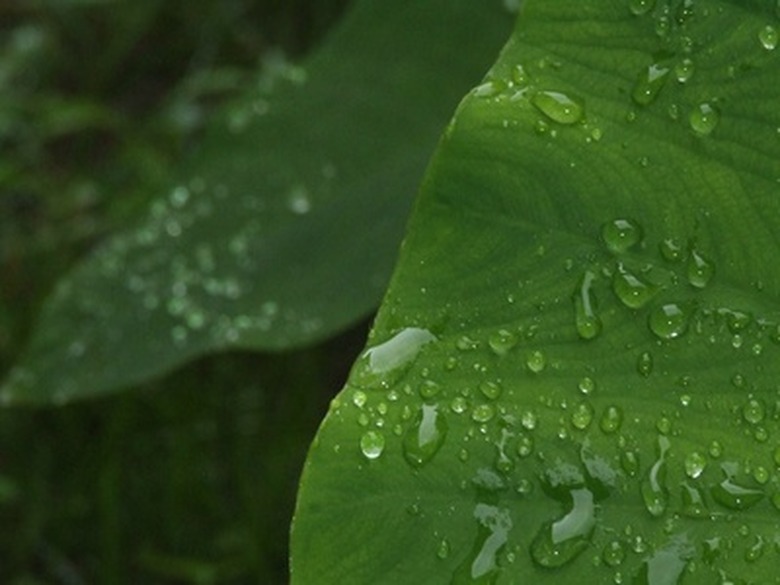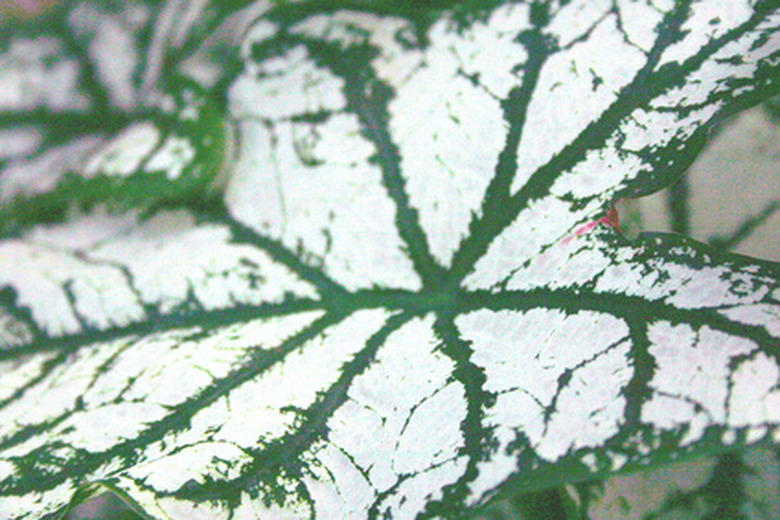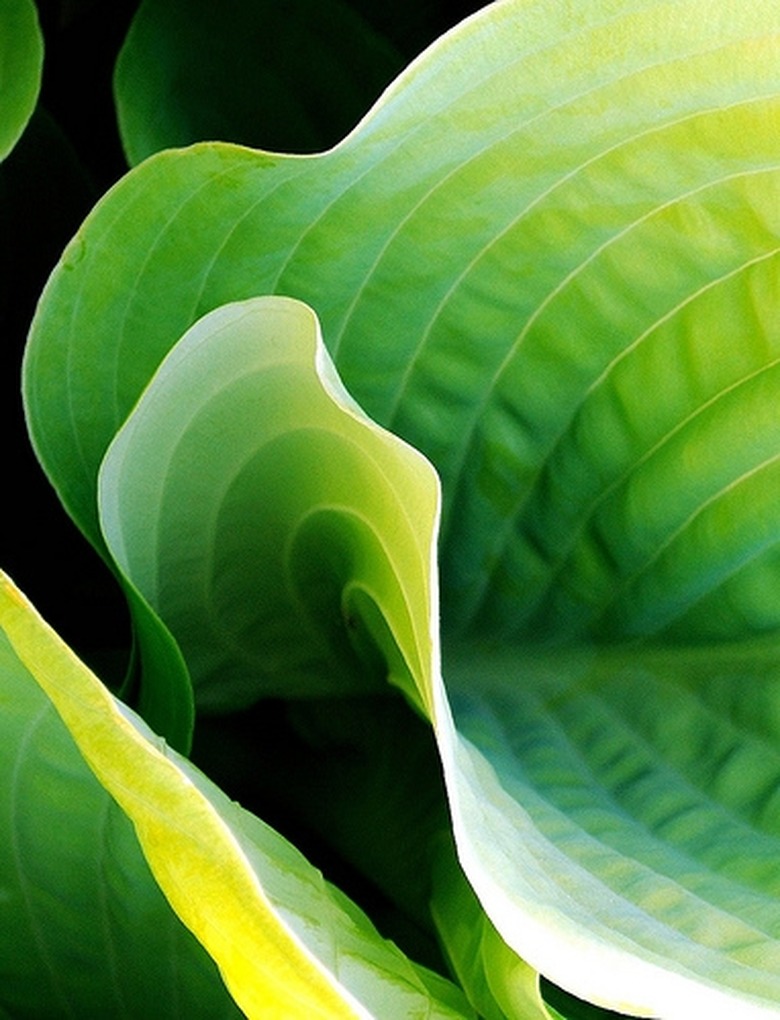Elephant Ear Plants
Step 1
The rabbit ears plant, or Ruttya fruticosa, is a vining shrub native to tropical Africa. The nectar-filled flowers are dark orange or yellow and from the front, resemble the head and ears of a rabbit. It is also sometimes called orange bird or hummingbird plant.
The rabbit ears plant, or Ruttya fruticosa, is a vining shrub native to tropical Africa. The nectar-filled flowers are dark orange or yellow and from the front, resemble the head and ears of a rabbit. It is also sometimes called orange bird or hummingbird plant.
Cool Colocasias, also known as Mammoth Elephant Ears, will begin to grow 21 days after they are first planted. Varieties of mammoth elephant ears can grow to reach nine feet in height. These plants are heavy feeders and require a lot of nutrients. They can also be planted in water such as koi ponds.
- The rabbit ears plant, or Ruttya fruticosa, is a vining shrub native to tropical Africa.
- The nectar-filled flowers are dark orange or yellow and from the front, resemble the head and ears of a rabbit.
Similarities
Alocasia and Colocasia more than belong to the same plant family. Gardeners refer to them by a nickname "elephant ears." This is in tribute to the large, flappy heart shapes of their leaves.
Alocasia Characteristics
Alocasia plants hold their leaves horizontally, with the tips sort of pointed upward. Also, Alocasias tend to prefer some shade and well-drained soil.
Colocasia Characteristics
By contrast, Colocasia plants hold their leaves downward. Moreover, Colocasia prefer full sunlight and lots of water.
- Alocasia and Colocasia more than belong to the same plant family.
- Alocasia plants hold their leaves horizontally, with the tips sort of pointed upward.
Xanthosoma
Another member of the Araceae family, Xanthosoma is similar to Colocasia in how it holds its leaves and how soft they are compared with Alocasia. But Xanthosoma leaves are more arrow-shaped than heart-shaped.
Edible or Not?
Some leaves from these plants are edible, while some are not. The best way to find out–or rather, to avoid the nonedible ones–is to stick to the leaves sold at your local grocery store.
Caladium, also known as "elephant ear," is grown from a bulbous tuber that can be dug up and stored indoors in a cool place like a basement through the winter months and replanted in the spring. Caladium can overwinter outdoors in warmer growing climates.
Step 1
Buy large, firm bulbs or tubers from a reliable source. Keep the bulbs in a cool, dry place until you are ready to plant them.
- Another member of the Araceae family, Xanthosoma is similar to Colocasia in how it holds its leaves and how soft they are compared with Alocasia.
- Caladium, also known as "elephant ear," is grown from a bulbous tuber that can be dug up and stored indoors in a cool place like a basement through the winter months and replanted in the spring.
Step 2
Plant the bulbs after the last frost of the year, when temperatures at night reach 50 degrees or above.
Step 3
Choose a site with moist to boggy organic soil in partial shade or shade that is protected from the wind.
Step 4
Use a trowel to dig a hole deep enough so that the top of the bulb is two inches below the surface of the soil. Set the bulb in the hole with the blunt end down and cover with soil. Space the bulbs 24 inches apart.
Step 5
Use a liquid fertilizer with a high nitrogen content at the rate recommended by the manufacturer. Continue applying fertilizer on a weekly basis during growing season.
- Plant the bulbs after the last frost of the year, when temperatures at night reach 50 degrees or above.
- Use a trowel to dig a hole deep enough so that the top of the bulb is two inches below the surface of the soil.
Warning
Wild Taro (Colocasia esculenta) is invasive in warm climates. Check with your local County Extension Office for more information. All parts of Elephant Ears can cause stomach distress if eaten raw, and the sap can irritate your skin.
Things Needed
- Trowel
- Liquid fertilizer
Step 1
Watch the elephant ears around the first light frost. When the foliage turns light brown, this is an indication the plant is going dormant.
Step 2
Cut the plant back to 2 to 4 inches from the ground with pruning shears a few days after this frost. Carefully dig up the tubers with a potato fork or spade.
Step 3
Wash the soil off the tubers with water. Set them out to dry out of the sun until they are dry to the touch.
Step 4
Store the elephant ears tubers in a milk crate surrounded by sawdust or peat moss. This will provide the tubers with enough moisture to last through the winter. Place them in a cool area, such as a cellar or crawl space.
- Watch the elephant ears around the first light frost.
- Store the elephant ears tubers in a milk crate surrounded by sawdust or peat moss.
Step 5
Re-pot the tubers indoors in a pot filled with half peat and half perlite, six to eight weeks before the last frost date. Keep the plant moist. This will give the elephant ears a head start for the growing season.
Caladium, also known as "elephant ear," are tropical annuals that grow best in soil temperatures between 70 to 80 degrees. Plant tubers or seedlings in late May after the chance of frost has passed. Check the USDA Hardiness Map to determine when frost has passed for your particular growing zone.
Step 1
Stop watering the elephant ears. In the wild, they often grow in wetlands and require consistent soil moisture. Drying out the planting site dehydrates the plant and will kill it over the course of several weeks.
- Re-pot the tubers indoors in a pot filled with half peat and half perlite, six to eight weeks before the last frost date.
- Drying out the planting site dehydrates the plant and will kill it over the course of several weeks.
Step 2
Dig out the plant as an alternative to drying it. This method is faster than dehydration. Use a spade to remove the entire plant, including its underground corm. Avoid breaking its corm or leaving behind pieces of it, as these can sprout into new plants.
Step 3
Spray the elephant ear plant with a systemic glyphosate herbicide for a low-labor method of killing the plant. Mist the herbicide onto all exposed portions of the elephant ear. The plant will absorb the chemical and die within two weeks.
- Dig out the plant as an alternative to drying it.
- Spray the elephant ear plant with a systemic glyphosate herbicide for a low-labor method of killing the plant.
Warning
Don't ingest any portion of the elephant ear's foliage, as it can cause severe mouth and throat irritations.
Botanical Name
Members of the Araceae family, elephant ear or taro are known by the Latin name Colocasia esculenta.
Habit
Elephant ear plants can reach a height of 4 to 6 feet. One kind of elephant ear, the Borneo Giant, can grow to 15 feet; it is the second-largest undivided leafed plant in the world.
Color
Grown for their dramatic foliage, elephant ears range from greenish-black to pale green.
Hardiness and Range
Elephant ears are perennial below zone 7. They can be grown in colder climates but must be dug up and brought indoors in winter.
Requirements
Grow elephant ears in rich, moist soil. They grow best in partial shade.
- Members of the Araceae family, elephant ear or taro are known by the Latin name Colocasia esculenta.
- One kind of elephant ear, the Borneo Giant, can grow to 15 feet; it is the second-largest undivided leafed plant in the world.
Use
Large and sculptural elephant ears are used in the rear of the border as a backdrop for other plants.
Step 1
Cut off the leaves during the middle of the day when the leaves contain less water and nutrients. Keep the leaves that look healthy and are not shriveled or discolored on the front or back.
Step 2
Lay the elephant leaf in a shallow baking pan, a cookie pan with raised sides or a large cardboard box lid. Because elephant leaves can be quite large, a large plastic container designed to go under a bed may be the perfect choice.
Step 3
Cover the leaf with a ½-to-1-inch mix of one part borax (a laundry agent) and one part cornmeal. Clean, salt-free fine sand also is acceptable as a leaf cover.
- Large and sculptural elephant ears are used in the rear of the border as a backdrop for other plants.
- Cut off the leaves during the middle of the day when the leaves contain less water and nutrients.
Step 4
Brush away the drying agent gently after 10 to 14 days. The leaf should be dry.
Step 5
Spray the leaf with a clear varnish or lacquer to give it a shiny permanent finish.
Things Needed
- Clippers
- Container
- Borax
- Cornmeal
- Sand
- Varnish or Lacquer
Plant elephant ear bulbs with the blunt end down in moist soil. This end should be rough and may have root buds, while the top of the bulb is rounded or bumpy.
The elephant ear plant (Caladium hortulanum), also known as calidium or taro, is toxic to cats. Signs that a cat has ingested the leaves of the elephant ear are oral irritation, drooling, difficulty in swallowing and vomiting.
- Brush away the drying agent gently after 10 to 14 days.
- Plant elephant ear bulbs with the blunt end down in moist soil.
Size
Step 1
An Elephant Ear Plant can grow to 3 to 5 feet in height when fully mature. (See Reference 1)
General Care
Step 1
Plant the Elephant Ear Plant in an area that receives partial shade with nutrient-rich soil. Keep the plant well watered. Cold temperatures are not well tolerated. (See Reference 2)
Propagation
Step 1
Dig up an existing plant to propagate by dividing the bulbs and roots in to three separate sections. Replant all sections and care for them as normal. (See Reference 3)
Step 2
- An Elephant Ear Plant can grow to 3 to 5 feet in height when fully mature.
- ( See Reference 1) Plant the Elephant Ear Plant in an area that receives partial shade with nutrient-rich soil.
Geography
Step 1
The Elephant Ear Plant is native to parts of Asia. As a perennial, it grows best in USDA zones 8 to 11 (warmer climate regions stretching from Florida to Texas), but can be grown as an annual in other areas by digging up the bulb to replant the following year.
Fun Facts
Step 1
The bulb of the Elephant Ear Plant can be cooked and eaten when mature by roasting or frying. Young leaves are also cooked and eaten in some areas. The plant loses its toxicity when cooked.
One variety, the Wetland taro, is the source of the Polynesian food poi.
Warnings
Step 1
All parts of the Elephant Ear Plant can cause stomach aches if ingested without cooking. Contact with the sap can irritate sensitive skin.
Colocasia esculenta, wild taro, is an invasive exotic in much of peninsular Florida. It is listed by the Florida Exotic Pest Plant Council as a Category I Species, known to be disrupting native plant communities and displacing native plant species.
Step 2
- The Elephant Ear Plant is native to parts of Asia.
- The bulb of the Elephant Ear Plant can be cooked and eaten when mature by roasting or frying.
Description
Step 1
Most sponges live in the ocean, although a few live in freshwater. Among the marine sponges is the elephant ear sponge (Agelas clathrodes). When living, this sponge is a brilliant orange shade on the outside and light orange within. Its massive, compressed form rises from a narrow base. This sponge's outer skin is fleshy and rough to the touch. It can grow to widths of 13 inches.
Range
Step 1
The elephant ear sponge inhabits coral reefs in the Gulf of Mexico and the Caribbean Ocean. Specimens have been observed in Barbados, Belize, the Cayman Islands, Colombia, Costa Rica, Cuba, Haiti, Jamaica, Mexico, Panama and Venezuela.
Step 2
- Most sponges live in the ocean, although a few live in freshwater.
- The elephant ear sponge inhabits coral reefs in the Gulf of Mexico and the Caribbean Ocean.
Uses
Step 1
Elephant ear sponges are utilized for decorative purposes in saltwater aquariums. They are also harvested and dried for use by painters and other artisans, who prize them for their texture.
Elephant Ear Plants with Color
Not all elephant ear plants have completely green foliage. Alocasia boa elicits a true tropical ambiance with its captivating blue tones and leaves that grow in an arrow-like shape. Imperial taro can be grown as an annual. Its lush leaves are a purple to black in hue with green veins. It is an ideal, winter-hardy specimen for planting zone 7. Alocasia micholitziana 'Frydek' produces striking white veins on its emerald green leaves, which typically reach up to 18 inches in length. It is tolerant of many growing conditions.
- Elephant ear sponges are utilized for decorative purposes in saltwater aquariums.
- Alocasia boa elicits a true tropical ambiance with its captivating blue tones and leaves that grow in an arrow-like shape.
Extreme of Sizes for Elephant Ear Plants
Alocasia robusta is the largest elephant ear plant, growing up to 30 feet tall. To grow properly, it requires high humidity and bright, indirect light. On the smaller end, Alocasia Silver Okinawa Variegata typically reaches 2 to 3 feet in height. It is also one of the easiest elephant ear plants to grow. It can withstand a range of growing conditions from drought to extensive exposure to rain–without the risk of becoming diseased.
Elephant Ear Plants for Containers
Black Magic and Green Giant make excellent specimens for containers within a garden. Both plants grow to be about 3 to 5 feet tall. The leaves of the Black Magic plant are a burgundy to black color, while Green Giant plants produce green foliage, as the name implies.
- Alocasia robusta is the largest elephant ear plant, growing up to 30 feet tall.






